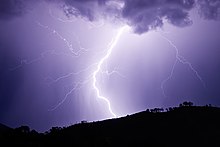User:Gkst41x

Static electricity means the increase of electric charge on the surface of objects. this electric charge remain on an object until they either flow into ground or lose their charge quickly by a discharge. Charge exchange can happen in the codition like rubbing and seperate different objects. a static charge will only remain when at least one of the surfaces has a high resistance to electrical flow. The effects of static electricity are familiar to most people because we can see, feel and even hear the spark. This spark happen when the excess charge is neutralized. This neutralization occurs when excess charge flow into electrical conductor (for example a path to ground). other charge flow occurs when a charged object is near a region with an excess charge of the opposite polarity (positive or negative). The familiar phenomenon of a static 'shock' is caused by the neutralization of charge [2].
History[change | change source]
In greek age, Thales found static electricity condition when he cleaning his amber. but at that time, they don't pay attention to this conditions and don't research about it. they just knows tha rubbing something make pulling force. earnest research for static electricity was started in 17C. In 17c, Otto von Guericke make first friction generator. And in 18C, Coulomb started reserch for fixed quantity of static electricity. Benjamin Franklin connected static electricity to storm. In 1832, Michael Faraday published the results of his experiment on the identity of electricities. this report proved that the electricity made by using a magnet, voltaic electricity produced by a battery, and static electricity were all the same. Since Faraday's result, the history of static electricity be thought as the study of electricity in general[3].
Charge[change | change source]
many situation can cause static electiricity.
1. Contact make charge separation Most materials have a unique chemical attraction for electons. Because of this, rubbing different material can cause charge separation. The material will have a positive charge if the material have a lower attraction for electons than other material.
2. Pressure make charge separation strong enough pressure make a separation of charge in certain types of materials like crystals and ceramics molecules.
3. Heat make charge separation Heating a certain materials can give electrons power. By this power, electrons break free from atoms. the atoms loosing electrons become a positive charge.
4. Charge make charge separation A charged objects can make neutral object have charge separation. Charges of the same the poles(negative to negative or positive with positive) are repelled and charges of the opposite polarity are attracted.This force make the near charged object part of neutral object have opposite pole of charged object. longer distance of two object make this force rapidly weaken. The effect is most occured when the neutral object have a charges which can move freely.
Discharge[change | change source]
Static discharge is that excess charge is neutralized by a flow of charges from or to the surroundings. positive charges get a electrons from the surroundings, and negative charges loose their electrons to surroundings.
The feeling of a static electric shock is caused by the stimulation of nerves as the neutralizing current flows through the human body. Due to presence of much water in the body, the charge is generally not enough to cause a dangerously high current. and lightening is also one example of Static discharge. A cloud gets a very huge charge by clash with oher cloud and it give off the excess charge to ground. But this huge charge never occur in the human's surroundings naturally.
Despite the apparently harmless nature of static electricity. There can be significant risks in the research because large charge can break down the equipment for research.
